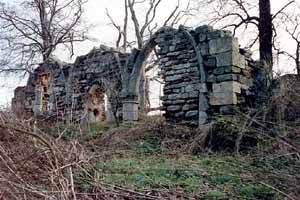 HaughtonChapel of St James the GreatNewark Archdeaconry Newark and Southwell Deanery Introduction
The ruins of Haughton chapel stand secluded in a small spinney on the south
bank of the river Maun, surrounded on three sides by extensive ploughland.
There is no village in Haughton today and the ruins are isolated from the few
scattered dwellings of the parish. Only the infilled arcading of a once-existing
aisle, in its present surviving form representing the north nave wall, stands
to any significant height. Collapsed masonry and rampant undergrowth obscure
other vestigial vertical structures.
In the Domesday survey Haughton has no church, but Saxo-Norman architectural
elements indicate that building probably commenced soon afterwards. Constructed
of ashlar, dressed coursed rubble, and coursed rubble, in a simple nave and
chancel form, its dimensions closely replicate those of many other early Norman
churches. Structural enhancements were effected in the late twelfth, fourteenth,
and sixteenth centuries.
Originally serving as a small parish church, its function changed to that
of domestic chapel to Haughton Hall at the emparkment of Haughton in 1509.
From the beginning of the eighteenth century when the Hall was abandoned, the
unused and neglected chapel fell into ruin. Considerable deterioration has
occurred despite Grade II* listing in 1952.
Particular thanks to Jo Ellis, Sheila Mortimer and Andy Nicholson for research
on this entry and to
Geoff Buxton, Aubrey Elliot, Vic Hall and Andy Nicholson for the photographs
|